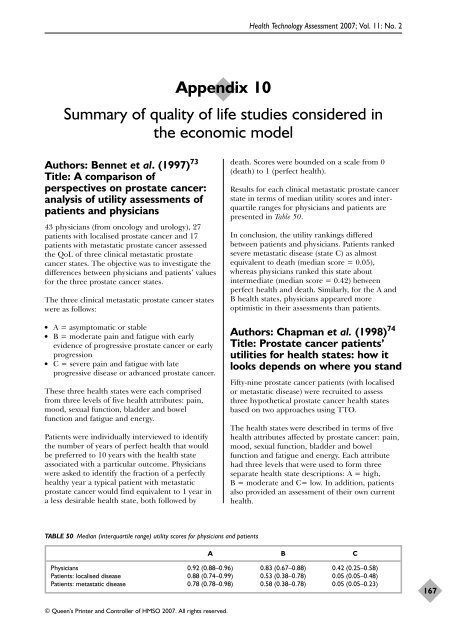Docetaxel with prednisone or prednisolone for the treatment of ...
Docetaxel with prednisone or prednisolone for the treatment of ...
Docetaxel with prednisone or prednisolone for the treatment of ...
Create successful ePaper yourself
Turn your PDF publications into a flip-book with our unique Google optimized e-Paper software.
Auth<strong>or</strong>s: Bennet et al. (1997) 73<br />
Title: A comparison <strong>of</strong><br />
perspectives on prostate cancer:<br />
analysis <strong>of</strong> utility assessments <strong>of</strong><br />
patients and physicians<br />
43 physicians (from oncology and urology), 27<br />
patients <strong>with</strong> localised prostate cancer and 17<br />
patients <strong>with</strong> metastatic prostate cancer assessed<br />
<strong>the</strong> QoL <strong>of</strong> three clinical metastatic prostate<br />
cancer states. The objective was to investigate <strong>the</strong><br />
differences between physicians and patients’ values<br />
f<strong>or</strong> <strong>the</strong> three prostate cancer states.<br />
The three clinical metastatic prostate cancer states<br />
were as follows:<br />
● A = asymptomatic <strong>or</strong> stable<br />
● B = moderate pain and fatigue <strong>with</strong> early<br />
evidence <strong>of</strong> progressive prostate cancer <strong>or</strong> early<br />
progression<br />
● C = severe pain and fatigue <strong>with</strong> late<br />
progressive disease <strong>or</strong> advanced prostate cancer.<br />
These three health states were each comprised<br />
from three levels <strong>of</strong> five health attributes: pain,<br />
mood, sexual function, bladder and bowel<br />
function and fatigue and energy.<br />
Patients were individually interviewed to identify<br />
<strong>the</strong> number <strong>of</strong> years <strong>of</strong> perfect health that would<br />
be preferred to 10 years <strong>with</strong> <strong>the</strong> health state<br />
associated <strong>with</strong> a particular outcome. Physicians<br />
were asked to identify <strong>the</strong> fraction <strong>of</strong> a perfectly<br />
healthy year a typical patient <strong>with</strong> metastatic<br />
prostate cancer would find equivalent to 1 year in<br />
a less desirable health state, both followed by<br />
Appendix 10<br />
Health Technology Assessment 2007; Vol. 11: No. 2<br />
Summary <strong>of</strong> quality <strong>of</strong> life studies considered in<br />
<strong>the</strong> economic model<br />
TABLE 50 Median (interquartile range) utility sc<strong>or</strong>es f<strong>or</strong> physicians and patients<br />
© Queen’s Printer and Controller <strong>of</strong> HMSO 2007. All rights reserved.<br />
death. Sc<strong>or</strong>es were bounded on a scale from 0<br />
(death) to 1 (perfect health).<br />
Results f<strong>or</strong> each clinical metastatic prostate cancer<br />
state in terms <strong>of</strong> median utility sc<strong>or</strong>es and interquartile<br />
ranges f<strong>or</strong> physicians and patients are<br />
presented in Table 50.<br />
In conclusion, <strong>the</strong> utility rankings differed<br />
between patients and physicians. Patients ranked<br />
severe metastatic disease (state C) as almost<br />
equivalent to death (median sc<strong>or</strong>e = 0.05),<br />
whereas physicians ranked this state about<br />
intermediate (median sc<strong>or</strong>e = 0.42) between<br />
perfect health and death. Similarly, f<strong>or</strong> <strong>the</strong> A and<br />
B health states, physicians appeared m<strong>or</strong>e<br />
optimistic in <strong>the</strong>ir assessments than patients.<br />
Auth<strong>or</strong>s: Chapman et al. (1998) 74<br />
Title: Prostate cancer patients’<br />
utilities f<strong>or</strong> health states: how it<br />
looks depends on where you stand<br />
Fifty-nine prostate cancer patients (<strong>with</strong> localised<br />
<strong>or</strong> metastatic disease) were recruited to assess<br />
three hypo<strong>the</strong>tical prostate cancer health states<br />
based on two approaches using TTO.<br />
The health states were described in terms <strong>of</strong> five<br />
health attributes affected by prostate cancer: pain,<br />
mood, sexual function, bladder and bowel<br />
function and fatigue and energy. Each attribute<br />
had three levels that were used to f<strong>or</strong>m three<br />
separate health state descriptions: A = high,<br />
B = moderate and C= low. In addition, patients<br />
also provided an assessment <strong>of</strong> <strong>the</strong>ir own current<br />
health.<br />
A B C<br />
Physicians 0.92 (0.88–0.96) 0.83 (0.67–0.88) 0.42 (0.25–0.58)<br />
Patients: localised disease 0.88 (0.74–0.99) 0.53 (0.38–0.78) 0.05 (0.05–0.48)<br />
Patients: metastatic disease 0.78 (0.78–0.98) 0.58 (0.38–0.78) 0.05 (0.05–0.23)<br />
167
















